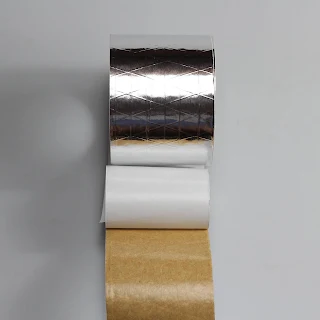Central air conditioner ducts are often
routed through unconditioned zones in the building. A metal duct conveying
cool, conditioned air through a broiling attic in summer or warm air through a
chilly crawl space in winter may lose a substantial amount of temperature. On
average the air ducts leak around 20% to 30% of the air conditioned or heated
air. These losses can be reduced by insulating metal ductwork with wrap-around
insulation. In order to help improve efficiency, it’s important to seal all of
the air ducts joints with Air conditioner tapes.
With dozens of options in HVAC tapes,
determining which one is right for your job is critical. It’s important to
consider factors like UL Listings, the type of surface the tape must adhere to,
and whether the tape has the strength and longevity to hold throughout the
system’s life span.
Aluminum Foil Backing
The first consideration in tape selection
is backing. Most Air conditioner ductwork applications necessitate a tape with
a pure foil or laminated foil backing, although there are some reinforcedAluminum foil tapes which are robust enough to be used in Air conditioner ductwork
applications. Both are designed to provide full system closure – meaning the
system is free of air leaks – and are durable and robust enough for the life of
the system.
If the pure aluminum foil is strength large
enough, increase the thickness of the aluminum foil, so that the cost is very
expensive. We usually use reinforced aluminum foil to increase its tensile
strength but not much production costs. Reinforced aluminum foil tape include
FSK tape, Aluminum foil glass cloth tape, Foil scrim tape, PET laminated foil
tape.
Above Air conditioner tapes allow for
maximum surface contact with the adhesive by easily conforming to rough and
uneven surfaces, which makes them an excellent option for sealing flexible duct
and reflective insulation.
However, because of their robust
construction and durability, Air conditioner tapes are the most common for Air
conditioner ducts jobs.
Adhesive layer
The second consideration in tape selection
is Adhesive layer.
Synthetic
rubber resin adhesive is synthetic rubber adhesive
systems. The synthetic rubber adhesive alone does not posse any adhesive
properties, and must be combined with tackifier resins to create a PSA. It
also named Hot melt adhesive.
Rubber-resin Adhesive will be offer good
tack and adhesion to a variety of surfaces, but will not perform well in
colder temperatures.
Water-based
acrylic adhesive and Solvent-based acrylic adhesive
Acrylic Adhesive is industrially
manufactured, and thus can be manipulated based on the selection of the
monomers used in the formulation.
Acrylic adhesive will be offer good tack
and adhesion to width range of temperature (from -30
degrees to 150 degrees ).
Water-based acrylic adhesive will be good
aging stability, high resistance to UV, ozone and humidity, best useful in
long-term, outdoor applications.











